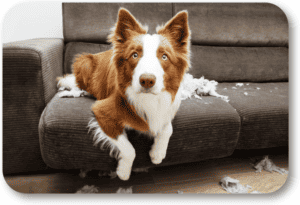Robin and I were talking to a new client in Acworth about Harvey, his Bull Terrier. Every time he would leave the house, he said that Harvey would get super excited, go crazy, and just “get nuts”. Harvey would bark like crazy, gnaw the baseboards, “eat furniture”, and yank everything he could find on tables (or even the walls) onto the ground. He said that they first tried getting a crate for Harvey and putting him in there whenever they left.

He just got crazier, and they were afraid he would hurt himself in there. He said that he tried every suggestion from friends, his Vet, and their groomer. He googled and read everything he could find on the internet. Nothing seemed to help. He asked us what we suggested to keep Harvey calm when they were out of the house…
We explained that Harvey was displaying the classic symptoms of separation anxiety. Whenever the family leaves the house, Harvey is left alone and becomes extremely anxious, scared, and (normally) destructive. I told them that if they had a camera set up in their home, they would probably observe Harvey nervously pace and wait by the door. If they had windows facing the front of the house, Harvey would probably stare out of them or even get up on the window ledges to stare outside.
As I just mentioned, Harvey’s nervous situation often plays out in random, destructive activities. This is when they would see the baseboards chewed up, pillows and furniture ripped apart, and stuff scattered all around the house. In one extreme case, I told him of an instance where two dalmatians had eaten their way through a wall when the client had left the house. (No kidding!)
Separation always begins with anticipation. When Harvey can anticipate the family’s departure and his “upcoming solitary confinement”, his adrenaline will quickly spike. This will make the impending matters just that much worse. I told my client that the first thing we recommend in order to curtail a dog’s separation anxiety is to remove his anticipation of their departure and the ensuing events.
I went on to explain that we all are “creatures of habit”. We often have “set routines” that we perform when we are about to do things. Almost all of us have “creatures of habit activities” when we leave the house. Examples of these activities are often:
- We get our keys off the key hook in the pantry.
- We check to make sure that all the doors are locked, and the windows are closed.
- We turn off all the lights.
- We put on our shoes and grab a coat.
- We get our wallet or purse from the bedroom dresser.
- And, many other “we are leaving” things.
It is often the case that we start this process long before we actually leave. But, the kicker is that we always leave after we complete the process. Harvey is carefully watching us all day and has a clear idea of what we are doing, the order, and why. As soon as he begins to see the “We are starting to do the things that we always do before we leave the house” routine, his adrenaline and potential anxiety begins to spike. To litigate Harvey’s anxiety, we must “hide” our “Going away” routine.
I told our client to do the following:
- Take the next several days and document every action they perform just before they leave the house. The list should include items they perform starting from about thirty minutes before they actually walk out the door. After several days, they should sit down and review all of their “I am going away” lists. While reviewing the lists, they should search for repetitive patterns of activities. These are the activities that are going to stand out to Harvey as indicators of their “I am going away” routine.
- Once they have their list of “repetitive things they do just before they leave the house”, they should make it a point to mix up their routine every time they go out the front door. I suggested that they look at their list and simply change the order of their actions. They could also merely not do some of the repetitive things when they leave. They could change what door they use to leave, and much, much more.
- I also said that they should begin to perform their “I am leaving” routine”, but don’t leave. Get all ready to leave, walk out the door, come right back inside, and sit down to watch TV. They should do this several times a day for the next fifteen to thirty days.
As you can see, all I have done is to ask my client and his family to eliminate the “I am leaving” pattern they have “taught Harvey”. Without a pattern to trigger him, there is no need for Harvey to become anxious because of those specific actions. I further emphasized that this is not a total solution for separation anxiety. But, it is the first step in curtailing the overall level of Harvey’s anxiety.
Please call or text us at (770) 718-7704 if you need any dog training help. You can also email us at [email protected]. We are blessed to have been your local dog training experts for over eighteen years. We have trained over 6,000 wonderful dogs and excellent families and are ready to help you.

Follow Us!